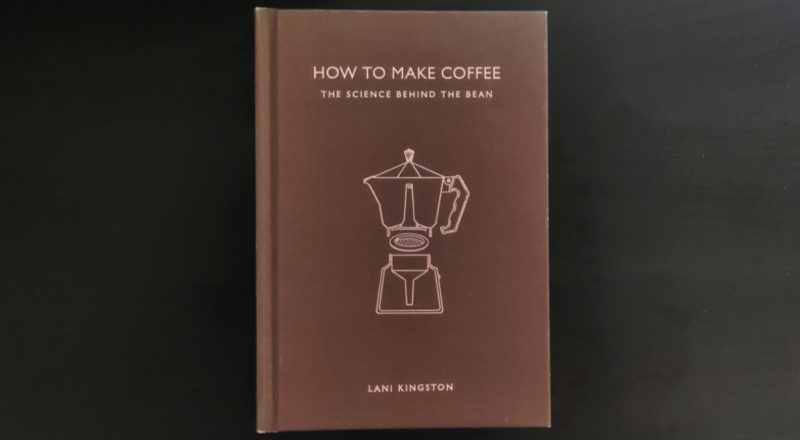I can’t remember exactly when and where I bought the book “How to Make Coffee: The Science Behind the Bean” by Lani Kingston, but it’s been sitting on our bookshelf for quite some time now.
Given that I’ve been focusing on making better pour over coffee recently and buying some new equipment, I thought it was a good time to dust it off and finally read it end-to-end. It’s a relatively small and short hardcover book at 160 pages and measuring 19cm by 13.5cm with a minimalist cover.
The table of contents gives a succinct overview of what to expect, and I found it to be a handy reference of all things coffee. It doesn’t promote itself as a comprehensive guide but it is concise and informative.

It starts with the coffee bean, which is the seed (or endosperm) of the coffee fruit, and introduces its origin, popularity and global spread over the centuries. It goes into the coffee family tree and lists out the different species and varietals, but coffee beans are generally classified as either Arabica, Robusta or Liberica with Arabica comprising more than 60% of global production and Liberica only comprising 1%

Coffee is a tropical crop and according to the International Coffee Organisation (ICO), the top 10 coffee producing countries are Brazil, Vietnam, Columbia, Indonesia, Ethiopia, India, Mexico, Guatemala, Peru and Honduras, with Brazil producing almost one-third of the world’s coffee.
Today, the vast coffee-cultivation area known as “the bean-belt” sits almost entirely within the humid equatorial region between the two tropics, comprising growing regions that have steady temperatures of around 20°C, rich soil, moderate sunshine and rain.

As an aside, I found it interesting that the coffee “bean-belt” is almost the inverse of the wine growing region, so you can either grow coffee or grapes but not both. And similar to grapes, different regions result in different flavour profiles though in the case of coffee, it seems to be more correlated to the cultivation altitude than terroir.

Once the coffee fruits are harvested, there are three methods of processing it to extract the green coffee bean — natural (dry), washed (wet) and semi-washed.
The natural method is the most traditional and the fruits are left intact and laid out to dry, resulting in more complex, sweet tasting and heavier-bodied coffee. The washed method requires a large amount of water and equipment, and results in more consistent and higher quality beans. The semi-washed method starts with the washed method but ends with natural drying and is used in specialty coffee production.
The book then goes into some amount of detail on the chemistry of caffeine and how its similarity to adenosine allows it to bind with receptors in the human body’s nervous system and preventing it from detecting adenosine levels and keeping us more alert.
I’ve never been a fan of organic chemistry and can only vaguely recall that there are these things called benzene rings, but the molecular structures in the book looked sort of familiar. In summary, blah blah caffeine blah blah metabolised into blah blah paraxanthine blah blah theobromine blah blah theophylline blah blah blood-brain barrier.
Or more importantly,
Caffeine encourages the production of epinephrine (adrenaline) and increases the levels of neurotransmitters such as dopamine, serotonin and acetylcholine, all of which are responsible for mood changes, among other things. Working in a similar way to adrenaline, caffeine increases breathing as well as the heart rate, resulting in a short burst of energy. Perhaps one of the primary reasons for coffee’s popularity is its ability to increase mental alertness with practically no negative side effects.
In short, caffeine good.
It was followed by a rather lengthy explanation on the science of decaffeination, which I totally skipped. Because, what’s the point?
The next section was more interesting to me, as it goes through the different components that go into brewing a good cup of coffee, starting with the different levels of roasting …

… to appropriate grind size for different brewing techniques …

… to optimal brewing temperatures …
The ideal temperatures for brewing are between 91°C and 96°C, and the closer to the higher figure, the better, although brewing coffee at boiling point, or 100°C, can often result in bitterness. Water below 91°C will under extract, resulting in weak and tasteless coffee.
… and acceptable water types.

There was also a short description on how to properly froth milk, which is important for creamy and sweet-tasting flat whites, not to mention critical for making latte art.

The final third of the book was dedicated to the different ways of making coffee (listed below). For each brewing method, a checklist of equipment needed and a step-by-step guide is provided. The write-up on espresso was particularly detailed, covering different drink types such as the Ristretto, Piccolo Latte, Macchiato etc.
- Cowboy Coffee
- Turkish Coffee
- Drip Coffee
- Filter Coffee
- Percolator
- Siphon
- Moka Pot
- Machine Espresso
- French Press
- Aeropress
- Cold Brew
One thing I learnt, that I didn’t know previously, was that there’s a difference between an Americano and a Long Black. To make an Americano, add water to espresso. To make a Long Black, flip the sequence and add espresso to water.
Why? So that the crema is retained. Which actually makes a lot of sense.
So, if you’re interested in making and/or drinking coffee, this book is quite a useful and interesting read. It won’t make you a professional barista, but it will explain what goes into the making of a good cup of coffee.
Plus, it looks good sitting on a bookshelf, which is always an important consideration when buying a physical book.
Image credits: How to Make Coffee, Lani Kingston
